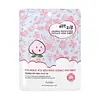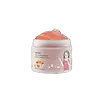What's inside
What's inside
 Key Ingredients
Key Ingredients

 Benefits
Benefits

 Concerns
Concerns

No concerns
 Ingredients Side-by-side
Ingredients Side-by-side

Water
Skin ConditioningGlycerin
HumectantAlcohol
AntimicrobialPEG/PPG-17/6 Copolymer
SolventButylene Glycol
HumectantSolanum Lycopersicum Fruit Extract
AntioxidantPunica Granatum Fruit Extract
AntioxidantHippophae Rhamnoides Extract
MaskingSodium Hyaluronate
HumectantBeta Vulgaris Root Extract
Skin ConditioningPrunus Persica Fruit Extract
AbrasiveCarbomer
Emulsion StabilisingTriethanolamine
BufferingXanthan Gum
EmulsifyingPEG-60 Hydrogenated Castor Oil
EmulsifyingPropylene Glycol
HumectantBetaine
HumectantDisodium EDTA
Methylparaben
PreservativePhenoxyethanol
Preservative1,2-Hexanediol
Skin ConditioningEthylhexylglycerin
Skin ConditioningCaprylyl Glycol
EmollientParfum
MaskingHexyl Cinnamal
PerfumingLinalool
PerfumingCitronellol
PerfumingWater, Glycerin, Alcohol, PEG/PPG-17/6 Copolymer, Butylene Glycol, Solanum Lycopersicum Fruit Extract, Punica Granatum Fruit Extract, Hippophae Rhamnoides Extract, Sodium Hyaluronate, Beta Vulgaris Root Extract, Prunus Persica Fruit Extract, Carbomer, Triethanolamine, Xanthan Gum, PEG-60 Hydrogenated Castor Oil, Propylene Glycol, Betaine, Disodium EDTA, Methylparaben, Phenoxyethanol, 1,2-Hexanediol, Ethylhexylglycerin, Caprylyl Glycol, Parfum, Hexyl Cinnamal, Linalool, Citronellol
Punica Granatum Fruit Water
AstringentGlycerin
HumectantButylene Glycol
HumectantSodium Hyaluronate
HumectantPanthenol
Skin ConditioningBetaine
HumectantAllantoin
Skin ConditioningCitrus Tangelo Peel Powder
Gardenia Taitensis Callus Extract
AntioxidantAscorbic Acid
AntioxidantHibiscus Syriacus Flower Extract
AntioxidantFicus Carica Fruit Extract
HumectantCamellia Sinensis Flower Extract
PerfumingRosa Rubiginosa Seed Oil
EmollientMorus Alba Fruit Extract
AntioxidantLycium Barbarum Fruit Extract
AstringentFragaria Ananassa Fruit Extract
Skin ConditioningAquilaria Malaccensis Stem Extract
AntioxidantHydroxyethyl Acrylate/Sodium Acryloyldimethyl Taurate Copolymer
Emulsion StabilisingCarbomer
Emulsion StabilisingPolyglyceryl-10 Laurate
Skin ConditioningPolyglyceryl-10 Myristate
Skin ConditioningOrange Roughy Oil
Skin ConditioningLitsea Cubeba Fruit Oil
MaskingTromethamine
BufferingEthylhexylglycerin
Skin ConditioningCaprylyl Glycol
Emollient1,2-Hexanediol
Skin ConditioningPunica Granatum Fruit Water, Glycerin, Butylene Glycol, Sodium Hyaluronate, Panthenol, Betaine, Allantoin, Citrus Tangelo Peel Powder, Gardenia Taitensis Callus Extract, Ascorbic Acid, Hibiscus Syriacus Flower Extract, Ficus Carica Fruit Extract, Camellia Sinensis Flower Extract, Rosa Rubiginosa Seed Oil, Morus Alba Fruit Extract, Lycium Barbarum Fruit Extract, Fragaria Ananassa Fruit Extract, Aquilaria Malaccensis Stem Extract, Hydroxyethyl Acrylate/Sodium Acryloyldimethyl Taurate Copolymer, Carbomer, Polyglyceryl-10 Laurate, Polyglyceryl-10 Myristate, Orange Roughy Oil, Litsea Cubeba Fruit Oil, Tromethamine, Ethylhexylglycerin, Caprylyl Glycol, 1,2-Hexanediol
 Reviews
Reviews

Ingredients Explained
These ingredients are found in both products.
Ingredients higher up in an ingredient list are typically present in a larger amount.
1,2-Hexanediol is a synthetic liquid and another multi-functional powerhouse.
It is a:
- Humectant, drawing moisture into the skin
- Emollient, helping to soften skin
- Solvent, dispersing and stabilizing formulas
- Preservative booster, enhancing the antimicrobial activity of other preservatives
Betaine is a common humectant (a substance that promotes retention of moisture). It's known to be gentle on the skin and can help balance hydration.
This ingredient is best for improving hydration and soothing irritated skin. Studies also show it helps even out skin tone.
Fun fact: Betaine is naturally created in the skin and body. The kind found within cosmetic products can be either plant-derived or synthetic.
Another name for betaine is trimethylglycine.
Learn more about BetaineButylene Glycol (or BG) is used within cosmetic products for a few different reasons:
Overall, Butylene Glycol is a safe and well-rounded ingredient that works well with other ingredients.
Though this ingredient works well with most skin types, some people with sensitive skin may experience a reaction such as allergic rashes, closed comedones, or itchiness.
Learn more about Butylene GlycolCaprylyl Glycol is a humectant and emollient, meaning it attracts and preserves moisture.
It is a common ingredient in many products, especially those designed to hydrate skin. The primary benefits are retaining moisture, skin softening, and promoting a healthy skin barrier.
Though Caprylyl Glycol is an alcohol derived from fatty acids, it is not the kind that can dry out skin.
This ingredient is also used as a preservative to extend the life of products. It has slight antimicrobial properties.
Learn more about Caprylyl GlycolCarbomer is a polymer of acrylic acid. Its main role is to create a gel consistency.
A high amount of carbomer can cause pilling or balling up of products. Don't worry, most products contain 1% or less of carbomer.
Ethylhexylglycerin (we can't pronounce this either) is commonly used as a preservative and skin softener. It is derived from glyceryl.
You might see Ethylhexylglycerin often paired with other preservatives such as phenoxyethanol. Ethylhexylglycerin has been found to increase the effectiveness of these other preservatives.
Glycerin is already naturally found in your skin. It helps moisturize and protect your skin.
A study from 2016 found glycerin to be more effective as a humectant than AHAs and hyaluronic acid.
As a humectant, it helps the skin stay hydrated by pulling moisture to your skin. The low molecular weight of glycerin allows it to pull moisture into the deeper layers of your skin.
Hydrated skin improves your skin barrier; Your skin barrier helps protect against irritants and bacteria.
Glycerin has also been found to have antimicrobial and antiviral properties. Due to these properties, glycerin is often used in wound and burn treatments.
In cosmetics, glycerin is usually derived from plants such as soybean or palm. However, it can also be sourced from animals, such as tallow or animal fat.
This ingredient is organic, colorless, odorless, and non-toxic.
Glycerin is the name for this ingredient in American English. British English uses Glycerol/Glycerine.
Learn more about GlycerinSodium Hyaluronate is hyaluronic acid's salt form. It is commonly derived from the sodium salt of hyaluronic acid.
Like hyaluronic acid, it is great at holding water and acts as a humectant. This makes it a great skin hydrating ingredient.
Sodium Hyaluronate is naturally occurring in our bodies and is mostly found in eye fluid and joints.
These are some other common types of Hyaluronic Acid:
Learn more about Sodium Hyaluronate